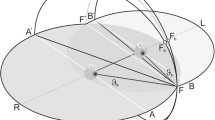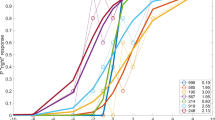Summary
By the use of scleral search coils a continuous record of human cyclovergence was obtained while two identical 80° textured patterns, presented dichoptically, oscillated in the frontal plane in counterphase through 1, 3 and 6° of cyclorotation at frequencies between 0.05 and 2 Hz. The amplitude and gain of the response decreased exponentially with increasing stimulus frequency. As stimulus amplitude increased, response amplitude also increased but gain was highest for low-amplitude cyclorotations. For an amplitude of 1° and a frequency of 0.05 Hz the gain reached 0.87 for two subjects. The phase lag increased from a few degrees at a frequency of 0.05 Hz to over 100° at a frequency of 2 Hz. These results suggest that cyclovergence is designed to correct for small, slow drifts in the stereoscopic alignment of the images in the two eyes. Although the disparity in the textured display was not interpreted as slant, it provided a strong stimulus for cyclovergence. The cyclovergence caused a transfer of cyclodisparity into a superimposed vertical line, which was then perceived as slanting in depth.
Similar content being viewed by others
References
Allen MJ, Carter JH (1967) The torsion component of the near response. Am J Optom 44:343–349
Ames A (1926) Cyclophoria. Am J Physiol Optics 7:3–38
Amigo G (1974) A vertical horopter. Optica Acta 21:277–292
Balliet R, Nakayama K (1978) Training of voluntary torsion. Invest Ophthalmol Vis Sci 17:303–314
Brecher GA (1934) Die optokinetische Auslösung von Augen-rollung und rotatorischem Nystagmus. Pflügers Arch Ges Physiol 234:13–28
Buizza A, Schmid R (1985) New experimental data on cat's optokinetic responses: is there need to revise previous models of the optokinetic reflex? Biol Cybern 51:301–304
Cheung BSK, Howard IP (1991) Optokinetic torsion: dynamics and relation to circularvection. Vision Res (in press)
Crone RA (1975) Optically induced eye torsion. II. Optostatic and optokinetic cycloversion. Von Graefes Arch Klin Ophthalmol 196:1–7
Crone RA, Everhard-Halm Y (1975) Optically induced eye torsion. I. Fusional cyclovergence. Von Graefes Arch Klin Exp Ophthalmol 195:231–239
Collewijn H, Van der Steen L, Ferman L, Jansen TC (1985) Human ocular counterroll: assessment of static and dynamic properties from electromagnetic scierai coil recordings. Exp Brain Res 59:185–196
Ferman L, Collewijn H, Van den Berg AV (1987) A direct test of Listing's law. I. Human ocular torsion measured in static tertiary positions. Vision Res 27:929–938
Gillis P, Godaux E, Beaufays J, Henri VP (1984) The optokinetic reflex in the cat: modeling and computer simulation. Biol Cybern 50:135–141
Godaux E, Vanderkelen B (1984) Vestibulo-ocular reflex, optokinetic response and their interactions in the cerebellectomized cat. J Physiol 346:155–170
Goodenough DR, Sigman E, Oltman PK, Rosso J, Mertz H (1979) Eye torsion in response to a tilted visual stimulus. Vision Res 19:1177–1179
Helmholtz, H von (1962) Treatise on physiological optics, Vol 3. Dover, New York, p 408
Hofmann, FB and Bielschowsky A (1900) Über die der Willkür entzogenen Fusionsbewegungen der Augen. Pflügers Arch Ges Physiol 80:20–28
Howard IP (1982) Human visual orientation. Wiley, Chichester
Howard IP, Templeton WB (1964) Visually induced eye torsion and tilt adaptation. Vision Res 4:433–437
Kertesz AE (1972) The effect of stimulus complexity on human cyclofusional response. Vision Res 12:699–704
Kertesz AE, Sullivan MJ (1978) The effect of stimulus size on human cyclofusional response. Vision Res 18:567–571
Krekling S (1973) Comments on cyclofusional eye movements. Von Graefes Arch Ophthalmol 188:231–238
Nagel A (1868) Über das Vorkommen von wahren Rollungen des Auges um die Gesichtslinie. Von Graefes Arch Ophthalmol 14:228–246
Ogle KN (1946) The binocular depth contrast phenomenon. Am J Psychol 59:111–126
Ogle KN, Ellerbrock, VJ (1946) Cyclofusional movements. AMA Arch Ophthalmol 36:700–735
Petrov AP, Zenkin GM (1973) Torsional eye movements and constancy of the visual field. Vision Res 13:2465–2477
van der Steen J, van Rijn LJ (1990) The oculomotor control of cyclovergence and cycloversion in humans. In: Proceedings 13th Europ Conf in visual perception. Perception 19:A60
Verhoeff FH (1934) Cycloduction. Trans Am Ophthalmol Soc 32:208–228
Author information
Authors and Affiliations
Rights and permissions
About this article
Cite this article
Howard, I.P., Zacher, J.E. Human cyclovergence as a function of stimulus frequency and amplitude. Exp Brain Res 85, 445–450 (1991). https://doi.org/10.1007/BF00229421
Received:
Accepted:
Issue Date:
DOI: https://doi.org/10.1007/BF00229421




